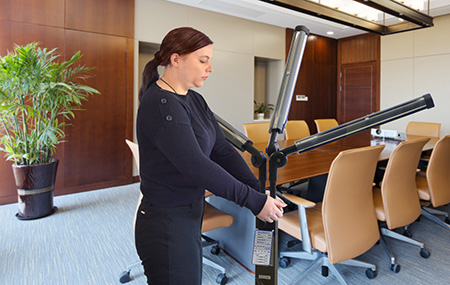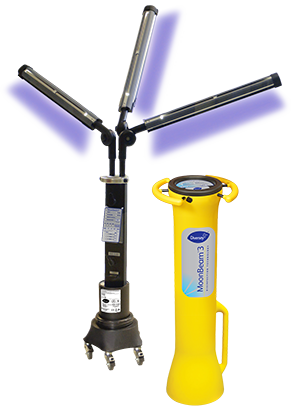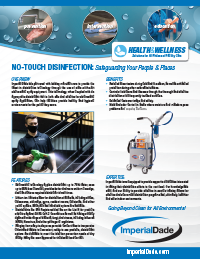Disinfecting high-touch surfaces in your facility is important to the health and safety of the people in your building
Regular cleaning and disinfecting are necessary to achieve a clean and healthy environment in your facility. However, maintaining the cleanliness of your building is likely more demanding for you and your cleaning team during periods of increased illness.
Using disinfecting wipes, a trigger sprayer, or a charging bucket and cloth to disinfect all the surfaces in your building can be tedious and time-consuming. These manual methods require your cleaning team to manually spray or wipe down surfaces and objects one by one.
These methods can be difficult if you have large surfaces, hard-to-reach objects, or areas where you can't apply enough disinfectant to satisfy the dwell time of the product.
Failing to fully coat a surface or meet proper wet dwell time can lead to germ spread from the ineffective application.
One way you can eliminate these issues is by integrating No-Touch Disinfection or NTD devices in your facility's cleaning and disinfecting program.
These devices will allow you to complete high-volume disinfection in your building efficiently, economically, and without the extra labor needed to manually disinfect each surface.

What is No-Touch Disinfection?
NTD or no-touch disinfection is an innovative cleaning technology that allows you and your staff to disinfect the surfaces in your facility without the need to manually touch each surface one by one.
Incorporating no-touch disinfection technology will reduce the amount of time it takes to disinfect large spaces in your facility and increase the efficacy of your program.
What are the Types of NTD?
There are several different types of NTD equipment that can be used in your facility. Each of these devices can be used to complete disinfection without the need for hands-on disinfection.
Some of these No-Touch Disinfection devices include:
- Electrostatic disinfection
- Ultraviolet C (UV-C) disinfection
- Disinfectant Fogger
- Disinfectant Vaporizer
- Electrostatic disinfection
- Ultraviolet C (UV-C) disinfection
- Disinfectant Fogger
- Disinfectant Vaporizer
Imperial Dade stocks equipment that can complete electrostatic disinfection and UV-C disinfection.
Where can No-Touch Disinfection be used?
Our experts recommend using No-Touch Disinfection Devices to achieve high-volume disinfection in a variety of facilities, including:
- Hospitals
- Nursing Homes
- Stadiums
- Offices
- Schools
- Gyms
- And more...
- Hospitals
- Nursing Homes
- Stadiums
- Offices
- Schools
- Gyms
- And more...
What Are the Benefits Of NTD?
No-touch disinfection offers a touch-free way for you and your cleaning staff to achieve a thorough germ-kill on the surfaces that your guests and building occupants touch.
By using an NTD device in your facility, your cleaning team can:
- Reduce the time and labor it takes to disinfect high-touch objects and surfaces. Instead of having to take extra time to manually disinfect each part of a surface or object, your staff can complete high-volume disinfection.
- Lower how much is spent on chemical disinfectants. Depending on the no-touch disinfection device you use in your facility, you can either reduce or eliminate the amount of chemical disinfectants your cleaning team needs to use.
- Reduce the time and labor it takes to disinfect high-touch objects and surfaces. Instead of having to take extra time to manually disinfect each part of a surface or object, your staff can complete high-volume disinfection.
- Lower how much is spent on chemical disinfectants. Depending on the no-touch disinfection device you use in your facility, you can either reduce or eliminate the amount of chemical disinfectants your cleaning team needs to use.

What Should You Consider When Selecting an NTD Device?
Whether or not a No-Touch Disinfection device is right for your facility will depend on a variety of factors.
Matching your facility with the right NTD equipment will depend on the unique needs of your business and guests.
You will want to examine your specific disinfection needs that need to be met to keep the people in your building safe and healthy.
Ensuring that you are eliminating the right pathogens from surfaces and objects will help you reduce the risk of disease transmission.

When choosing a No-Touch Disinfection device, you should consider:
- Your Facility TypeThe type of facility you have will affect what kind of NTD device you will be able to use.For example, in healthcare facilities, like hospitals, you will need to be careful when selecting an NTD device to ensure that you're using a method that aligns with the hospital's cleaning regulations.Some hospitals require that your disinfection method won't affect or cause complications for patients. If you have a patient with respiratory sensitivity, you likely won't use an electrostatic sprayer to avoid accidental disinfectant inhalation.
- Occupied Vs Unoccupied RoomsCertain systems cannot be used while there are occupants in the area.If the areas you will need to disinfect are commonly going to be occupied, you will need to decide on a device that will not cause negative health issues for your guests.
- Pathogens of ConcernWhen choosing a touch-free disinfection method for your facility, you'll need to know how the kill claims for the system and its compatible disinfectants.PRO TIP: Some NTD devices need to be paired with a chemical disinfectant, and not all those disinfectant chemicals have the same kill claims. These claims are regulated by the US Environmental Protection Agency (EPA) and can be found on the EPA-approved product label.This ensures it is effective against the most common pathogens in your facility. For example, if you're worried about bacteria that cause specific illnesses like COVID-19, Influenza, MRSA, C Diff, or other infections, you will want to make sure that the device or disinfectant you're using will target those germs.
- Cleaning FrequencyIf you need to disinfect the surfaces and objects in your facility frequently, you'll want to make sure that the amount of time it would take to complete cleaning and disinfecting won't affect your current available labor.The amount of time it would take to complete disinfection depends on the device you're using.A UV-C disinfection device usually takes about 3 minutes to disinfect a 30x30 room and doesn't require any downtime between uses, so you can disinfect an area more than once.An electrostatic disinfectant sprayer can disinfect up to 18,000 sq/ft per hour, making it about 75% faster than using a traditional trigger sprayer. After cleaning, the people in your building can enter right away and you can avoid long downtimes after cleaning
- Your Facility TypeThe type of facility you have will affect what kind of NTD device you will be able to use.For example, in healthcare facilities, like hospitals, you will need to be careful when selecting an NTD device to ensure that you're using a method that aligns with the hospital's cleaning regulations.Some hospitals require that your disinfection method won't affect or cause complications for patients. If you have a patient with respiratory sensitivity, you likely won't use an electrostatic sprayer to avoid accidental disinfectant inhalation.
- Occupied Vs Unoccupied RoomsCertain systems cannot be used while there are occupants in the area.If the areas you will need to disinfect are commonly going to be occupied, you will need to decide on a device that will not cause negative health issues for your guests.
- Pathogens of ConcernWhen choosing a touch-free disinfection method for your facility, you'll need to know how the kill claims for the system and its compatible disinfectants.PRO TIP: Some NTD devices need to be paired with a chemical disinfectant, and not all those disinfectant chemicals have the same kill claims. These claims are regulated by the US Environmental Protection Agency (EPA) and can be found on the EPA-approved product label.This ensures it is effective against the most common pathogens in your facility. For example, if you're worried about bacteria that cause specific illnesses like COVID-19, Influenza, MRSA, C Diff, or other infections, you will want to make sure that the device or disinfectant you're using will target those germs.
- Cleaning FrequencyIf you need to disinfect the surfaces and objects in your facility frequently, you'll want to make sure that the amount of time it would take to complete cleaning and disinfecting won't affect your current available labor.The amount of time it would take to complete disinfection depends on the device you're using.A UV-C disinfection device usually takes about 3 minutes to disinfect a 30x30 room and doesn't require any downtime between uses, so you can disinfect an area more than once.An electrostatic disinfectant sprayer can disinfect up to 18,000 sq/ft per hour, making it about 75% faster than using a traditional trigger sprayer. After cleaning, the people in your building can enter right away and you can avoid long downtimes after cleaning
These considerations will help you decide whether No-Touch Disinfection is right for you, and which NTD device will be most effective in your facility.
Once you've decided which device will be the most effective in your facility, you'll have to educate and train your staff on how to use, when to use, and where to use your equipment to maintain clean and sanitary surfaces.
Your Imperial Dade sales consultant has the resources, knowledge, and expertise to make the correct product recommendation for your specific needs. Please contact us to learn more about how No-Touch Disinfection can benefit your operation.
